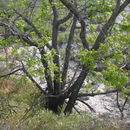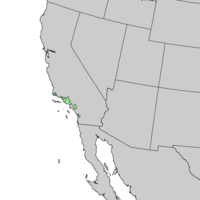fi
nimet breadcrumb-navigoinnissa


La noguera de Califòrnia (Juglans californica), noguera negra de Califòrnia o millor noguera del sud de Califòrnia (per distingir-la de la noguera de Hinds o noguera del nord de Califòrnia Juglans hindsii) del gènere Juglans és una espècie de gran arbust o petit arbre de 6-9(17) m d'alçària i que pertany a la família juglandàcies. És un endemisme de Califòrnia.
Aquesta espècie pot ser un arbust gran amb 1-5 troncs, o arbre petit, d'un sol tronc. El tronc principal pot desenvolupar-se prop del terra, fent que sembli com dos arbres que han crescut junts i després es van separar. Té una escorça gruixuda, profundament canalitzada o solcs a la maduresa. Té grans fulles pinnades compostes amb 11-19 folíols lanceolats amb les vores dentades i sense pèl en els angles de les venes.[1] El fruit consisteix en una petita nou dura amb una superfície ranurada, de closca gruixuda que és difícil d'eliminar.
J. californica es troba generalment a la part meridional de Califòrnia Coast Ranges, Transverse Ranges, Peninsular Ranges i la Vall Central. Creix com a part dels boscos mixtes, i també als vessants i a les valls on les condicions són favorables. Està amenaçada pel desenvolupament i el sobrepasturatge. Alguns rodals nadius romanen a la zona urbana de Los Angeles a les muntanyes de Santa Monica i Hollywood Hills. J. californica creix en riberes boscoses, tant en rodals d'una sola espècie o barrejat amb roures de Califòrnia (Quercus spp.) i àlbers (Populus fremontii).
Els indis Chumash de les Illes Anglonormandes de Califòrnia i el comtat de Ventura en menjaven la fruita seca, però aquestes no es produeixen comercialment per a aquest propòsit.
J. californica també es conrea com a arbre ornamental com a planta nativa de Califòrnia, xerojardineria, i hàbitat de vida silvestre de jardins i paisatgisme natural a Califòrnia i a Hawaii.[2][3]
Juglans californica va ser descrita per Sereno Watson i publicada a Proceedings of the American Academy of Arts and Sciences 10: 349, l'any 1875.[4]
La noguera de Califòrnia (Juglans californica), noguera negra de Califòrnia o millor noguera del sud de Califòrnia (per distingir-la de la noguera de Hinds o noguera del nord de Califòrnia Juglans hindsii) del gènere Juglans és una espècie de gran arbust o petit arbre de 6-9(17) m d'alçària i que pertany a la família juglandàcies. És un endemisme de Califòrnia.
Juglans californica, the California black walnut, also called the California walnut, or the Southern California black walnut,[1] is a large shrub or small tree (about 20–49 feet (6.1–14.9 m)[3]) of the walnut family, Juglandaceae, endemic to the Central Valley and the Coast Range valleys from Northern to Southern California.
Juglans californica is generally found in the valleys and adjacent slopes of the California Coast Ranges, Transverse Ranges, and Peninsular Ranges. It grows as part of mixed woodlands, and also on slopes and in valleys wherever conditions are favorable. It is threatened by development and overgrazing.[1] Some native stands remain in urban Los Angeles in the Santa Monica Mountains, Hollywood Hills, and Repetto Hills. J. californica grows in riparian woodlands, either in single species stands or mixed with California's oaks (Quercus spp.) and cottonwoods (Populus fremontii).
Juglans californica can be either a large shrub with 1–5 trunks, or a small, single-trunked tree. The main trunk can fork close to the ground, making it look like two trees that have grown together, then diverged. It has thick bark, deeply channeled or furrowed at maturity. It has large, pinnately compound leaves with 11–19 lanceolate leaflets with toothed margins and no hair in the vein angles.[4] It has a small hard nut in a shallowly grooved, thick shell that is difficult to remove.
The nuts are edible[5] and are eaten by the Chumash Indians of the Channel Islands of California and Ventura County as well as by the Tongva of Los Angeles County. They are not grown commercially as food.
Juglans californica is cultivated throughout California to support the walnut industry, used as a rootstock in English walnut orchards. It is also cultivated as an ornamental tree where it is planted in California native plant, xeriscape, and wildlife habitat gardens and natural landscaping in California, and in Hawaii.
Some authorities (e.g. the California Native Plant Society) combine this species with Juglans hindsii. On the other hand, a 2007 molecular analysis of the genus[6] suggests J. californica is sister to the remaining black walnuts (section Rhysocaryon). This article follows the conventions of The Jepson Manual.[7][8]
Juglans californica, the California black walnut, also called the California walnut, or the Southern California black walnut, is a large shrub or small tree (about 20–49 feet (6.1–14.9 m)) of the walnut family, Juglandaceae, endemic to the Central Valley and the Coast Range valleys from Northern to Southern California.
Juglans californica es una especie de gran arbusto o pequeño árbol que alcanza los un tamaño de 9 m de altura, perteneciente a la familia Juglandaceae. Es un endemismo de California.
J. californica se encuentra generalmente en la parte meridional de California Coast Ranges, Transverse Ranges, Peninsular Ranges y el Valle Central. Crece como parte de los bosques mixtos, y también en las laderas y en los valles donde las condiciones son favorables. Está amenazada por el desarrollo y el sobrepastoreo. Algunos rodales nativos permanecen en la zona urbana de Los Ángeles en las montañas de Santa Mónica y Hollywood Hills. J. californica crece en riberas boscosas, tanto en rodales de una sola especie o mezclado con robles de California ( Quercus spp.) y álamos ( Populus fremontii ).
Juglans californica puede ser un arbusto grande con 1-5 troncos, o un árbol pequeño, de un solo tronco. El tronco principal puede desarrollarse cerca de la tierra, haciendo que parezca como dos árboles que han crecido juntos y luego se separaron. Tiene una corteza gruesa, profundamente canalizada o surcos en la madurez. Tiene grandes hojas pinnadas compuestas con 11-19 foliolos lanceolados con los bordes dentados y sin pelo en los ángulos de las venas.[1] Tiene una pequeña nuez dura con una superficie ranurada, cáscara gruesa que es difícil de eliminar.
Los indios Chumash de la Islas del Canal de California y el condado de Ventura comían los frutos secos, sin embargo, estas no se producen comercialmente para este propósito.
J. californica se cultiva como árbol ornamental como planta nativa de California, xerojardinería y hábitat de vida silvestre de jardines y paisajismo natural en California, y en Hawái.[2][3]
Juglans californica fue descrita por Sereno Watson y publicado en Proceedings of the American Academy of Arts and Sciences 10: 349. 1875.[4]
Juglans; nombre genérico que procede del término latíno Juglans que deriva de Jovis glans, "bellotas de Júpiter": figuradamente, una nuez apropiada para un dios.
californica: epíteto geográfico que alude a su localización en California.
Juglans californica es una especie de gran arbusto o pequeño árbol que alcanza los un tamaño de 9 m de altura, perteneciente a la familia Juglandaceae. Es un endemismo de California.
Orzech kalifornijski (Juglans californica S. Watson) – gatunek drzewa należący do rodziny orzechowatych. Występuje w Ameryce Północnej, wyłącznie na terenie stanu Kalifornia, gdzie rośnie od Santa Barbara po pasmo gór San Bernardino[2][4].
Fanerofit. Roślina jednopienna, wiatropylna. Kwitnie późną wiosną. Spotykany przy brzegach rzek i strumieni oraz w górskich dolinach[4].
Orzech kalifornijski wpisany został do Czerwonej księgi gatunków zagrożonych w kategorii gatunek narażony (ang. Vulnerable – VU)[3].
Orzech kalifornijski (Juglans californica S. Watson) – gatunek drzewa należący do rodziny orzechowatych. Występuje w Ameryce Północnej, wyłącznie na terenie stanu Kalifornia, gdzie rośnie od Santa Barbara po pasmo gór San Bernardino.

Kalifornijski oreh (znanstveno ime Juglans californica) je listopadno drevo iz družine orehovk, ki je samoniklo na jugozahodu Severne Amerike.
Kalifornijski oreh je lahko velik grm, sestavljen iz do pet debel, lahko pa raste tudi ko posamično drevo. Deblo se lahko rogovilasto razdvoji že pri tleh, tako da včasih izgleda, kot da sta se zrasli dve drevesi. Skorja drevesa je debela in globoko razbrazdana. Listi so sestavljeni iz 11 do 19 manjših lisitčev[2]. Plod je koščičast in vsebuje po en droben oreh z užitnim jedrom. Lupina oreha je izjemno trda.
Kalifornijski oreh (znanstveno ime Juglans californica) je listopadno drevo iz družine orehovk, ki je samoniklo na jugozahodu Severne Amerike.
Juglans californica S. Watson
Охранный статусОре́х калифорни́йский (лат. Juglans californica) — деревянистое растение, вид рода Орех (Juglans) семейства Ореховых (Juglandaceae).
Дерево высотой 25 метров. Листья имеют 11—19 мелкозубчатых, туповатых или несколько заострённых листочков длиной 5—10 см и шириной 3—4 см, которые опушены по стержню и жилкам. Тычинок 30—40[2]. Серёжки длиной 5—14 см[3]. Плод — ложная костянка круглой формы, в диаметре достигает 4—5 см, мягко опушенная[2]. Плодов 4—5[3]. Орех продольно-бороздчатый, круглой или яйцевидной формы, с толстой скорлупой, в диаметре достигает 2,5—3,5 см[2]. Цветение происходит с марта по май[3].
Орех калифорнийский произрастает на склонах и ущельях на высоте 30—900 м[3]. Распространён в США, в штате Калифорния[4].
Орех калифорнийский входит в число уязвимых видов[5]. Эти растения растут изолированными группами, ареал их произрастания сужается. Угрожающими факторами являются урбанизация, выпас скота и низкая репродуктивность[5].
Вид Орех калифорнийский входит в род Орех (Juglans) семейство Ореховые (Juglandaceae).
Оре́х калифорни́йский (лат. Juglans californica) — деревянистое растение, вид рода Орех (Juglans) семейства Ореховых (Juglandaceae).